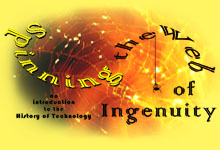
University of California, Irvine
Instructor: Dr. Barbara J. Becker

|
Lecture 1. Taming Material Elements
|
The word "technology" derives from the Greek word τεχνη [techné], which means "craft" or "art". Greek philosophers like Aristotle saw techné as one way to gain knowledge of the world. Becoming knowledgeable through the use of techné required working with one's hands -- doing physical labor, getting dirty, straining the body. For the Greeks, it lacked the elegance, sophistication and certainy of επιστημη [episteme]: knowledge gained through reason. We may have derived our word "technology" from the Greeks, but we -- like every other society and culture long before and ever since the word was coined -- have endowed it with a meaning that reflects our own evolving relationship with the natural and man-made world. We can learn about the technology of pre-literate peoples through the artifacts they have left behind. Indeed, the presence of artifacts helps us locate ancient sites of human habitation and follow the spread of early man around the globe. |
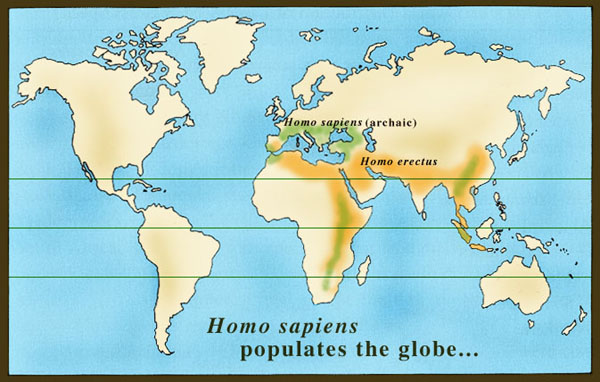
Earliest Homo sapiens modern (120,000 BP [Before the Present]) based on fossil evidence.
——————————

Range of Homo sapiens modern — to 30,000 BP
——————————
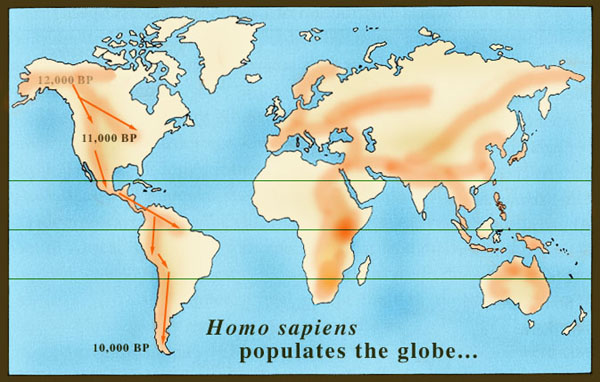
Range of Homo sapiens modern —
to 10,000 BP
(estimated world population:
4 million)
——————————
| Analysing artifacts uncovered at sites of ancient human habitation helps us
to reconstruct the methods by which the artifacts were produced and to assess the technological capabilities
of the people who made them.
Artwork found at sites may depict scenes of daily life. Excavators may uncover written documents containing detailed descriptions of a literate society's material culture. Drawings, carvings and written records offer clues to a society's level of social organization and technological sophistication, but these clues must be interpreted with caution. Skilled illustrators may lack familiarity or understanding of the activities they been asked to represent. Skilled scribes may lack training and expertise to write with authority on the subject they describe. And, it is important to keep in mind that illustrations and written material may not represent any real event or activity, but rather have a metaphorical, allegorical or supernatural purpose. The chart below provides a simplified graphical representation of the geographical distribution and technical capabilities of genus Homo over the past 100 million years. |
——————————
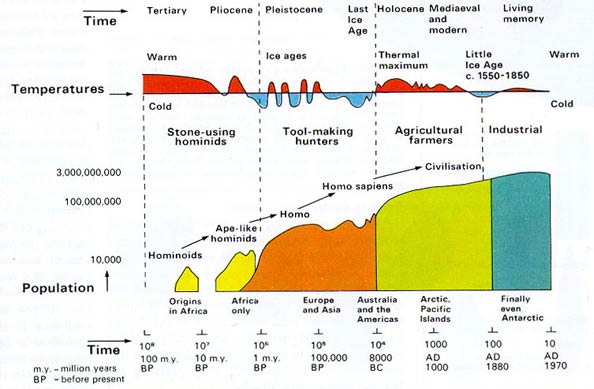
Geographical distribution and technical capabilities of genus Homo from 100 million years ago to the present.
——————————
Food Production Climate and local geography made some areas of the world welcoming environments for the development of purposeful food production -- planting, tending and gathering edible vegetation and domesticating animals. |
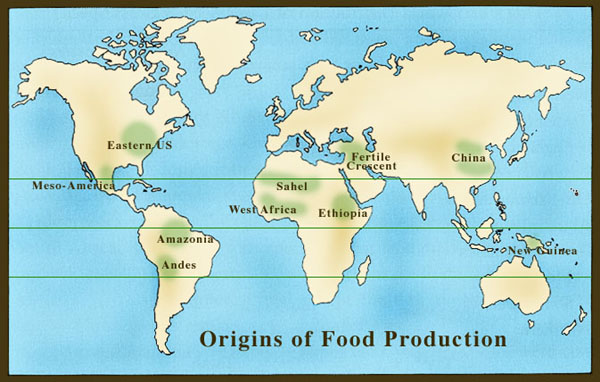
——————————
Forestland in the "Fertile Crescent" (see map, above) became amenable to the development of purposeful food production as the result of a combination of several factors: an increasingly drier climate, human logging activity and foraging of forest seedlings by grazing domesticated animals. The development of agriculture in the region between the Tigris and Euphrates rivers around 10,000 years ago was aided by its moderate climate as well as a topology and system of waterways that facilitated transportation and communication over long distances. |
||||||||||||||||
Most of wild land biomass is:
Domesticating animals introduces readily available source of protein, food product variety, non-food products, natural fertilizer, and work power. —————————— Plant Domestication
Opportunism — first hominids
Preference — first hominids
Husbandry — before 10,000 years BP
Cultivation — after 10,000 years BP
—————————— Animal Domestication Characteristics of wild animals suitable for domestication:
—————————— Early Domesticated Animals (years BP)
|
||||||||||||||||
—————————— |
Metal Working and Metallurgy
|
|
|
|
|
|
|
|
|
|
|
|
|
|
|
|
|
|
|
|
|
|
|
|
|
|
|
|
|
|
|
|
|
|
|
|
|
|
|
|
|
|
*These metals can be found in their elemental state in nature, or — with the general exception of gold — chemically bound to other elements in materials we call "ores". At normal temperatures, native gold, silver and copper can be shaped simply by hammering. Heating the metals gives the metalworker more options and greater control over the final product, but open wood fires only attain temperatures of about 650°C, so melting these metals was not possible until higher temperatures could be sustained. This occurred after the introduction of baking ovens. To bake or glaze properly, pottery requires a temperature of at least 800°C, which is about the temperature at which copper ore can be reduced (chemically converted to elemental copper, gas and ash). The Discovery of Copper Smelting?
The gemstone lapis lazuli was highly prized by Egyptians. |
—————————— There are two important phases in every technological development: its inception and its transmission. Historians like to search for records indicating:
The spread and adoption of technological ideas has always been uneven. One idea might spread quickly while others spread only after they are fully developed. Some regions were unable to adopt a new technology for lack of natural resources and/or human expertise. At times, the spread of technological ideas may have been accelerated or slowed by events for which there is no surviving record. |
—————————— Copper gets its name from "Cyprus", one of the early sites where its ore was found. Once freed from its ore, metallic copper can be polished. If you bend it, it will stay bent. It can be hammered, but not chipped, into shapes. Rings were among the earliest objects made of copper. These rings were not joined, but simply bent or hammered into an unclosed circle. Hammering copper can make it brittle. Heating brittle copper, a process called "annealing", restores its resiliency. How did humans discover how to extract metallic copper from its ore? |

|
Egyptian Faience  Was smelting an accidental by-product of faience production? |
Over 5000 years ago, to imitate the beauty of lapis lazuli, the Egyptians created a special kind of ceramic they called "tjehnet" — the same word they used for lapis. Today we call it Egyptian faience. It was made of crushed quartz, not clay, and was fired at a very high temperature, often with a glaze containing copper which gave the final product its characteristic blue color. The special conditions required to make faience -- high temperature, charcoal-fuelled oven, having just the right amount of air circulation -- are optimal for smelting copper. When copper ore is heated with charcoal and held at a temperature of 1000°C for many hours, the carbon in the charcoal combines with the oxygen in the ore thus releasing the metal. The copper can then be pounded into a desired shape, or melted and poured into a mold. |
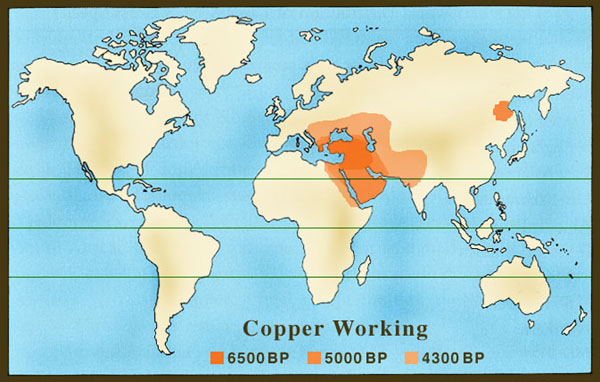
Copper smelting has long been viewed as an innovation that radiated from the Near East into Western Europe, India, and to the rest of the world. Excavations in Europe, Asia, and Africa have led some experts to dispute that claim and argue instead that copper smelting may have developed independently in many different sites. —————————— |
| The earliest known copper mine in the British Isles is located on Ross
Island in Ireland. Bronze Age mining and metalworking took place
at Ross Island between 4400 and 3800 years ago.
Ross Island mine opening. ——————————
The subterranean rooms in the Ross Island mine are filled with water, so they cannot be easily examined. This picture shows the interior of another, similar copper mine in Mynydd Parys, Wales. Soot on the walls and floor gives us evidence that fire was used to heat and crack surrounding limestone in order to extract the ore. ——————————
Stone hammers like this one were used to extract the ore from the mine's walls. ——————————
Grindstones were used to pulverize chunks of extracted ore. This was an activity that women, children and elderly individuals could participate in. This crushing process made it possible to remove more extraneous limestone in which the ore was embedded before placing it in the furnace. ——————————
An excavated smelting furnace near the opening of the Ross Island mine. ——————————
A piece of copper slag from a smelting furnace. The copper metal can be found inside. ——————————
A molded bronze hand-axe and a copper ingot found on the site of the Ross Island mine. |
—————————— |
Gold and Silver Gold rarely combines with other elements to create ores. To mine gold requires extracting it from the rock in which it is deposited. Ancient gold-seekers found a way to do this by letting Nature's erosive forces do the hard work. Their method, still used today, is called "panning" As gold-rich rock erodes, fragments of gold, gravel and dust are carried off by wind and rain and accumulate in nearby streambeds. To pan for gold, the mixed debris is scooped with some water into a shallow pan. When the water and debris is sloshed gently in the pan, the dense gold will settle at the bottom while the sand and grit will remain on top. Tilting the pan makes the water flow over the rim, carrying with it some of the undesirable minerals. Repeatedly flushing the pan's residual material with fresh water will remove more and more of the sand and grit and leave the gold behind. Unlike copper, gold does not harden when hammered. In fact it is possible to hammer gold into extremely thin sheets (gold foil). Pieces of gold can be joined by hammering them together. Silver is far more abundant than gold. But because silver does combine with other elements, it normally requires smelting or some sort of chemical treatment after removal from the earth to extract the pure metal. |
—————————— |
Bronze Less than 5000 years ago, metalworkers discovered that mixing a small quantity of tin ore with copper ore resulted in an alloy known today as bronze. Bronze is a more useful metal than pure copper. It is not only harder than copper, it has a lower melting point and so is easier to cast. Tinstone is a dense mineral. Tin does not occur naturally with deposits of copper ore. Instead, it often occurs in areas with veins of gold. Its small, heavy black lumps may have first been noticed in the residue left behind while panning for gold. Interest in bringing supplies of tin and copper together from distant locations to make bronze served as a stimulus for trade and communication. |
—————————— |
Iron Very little is known about the discovery of iron working. The spread of knowledge about iron working appears to have taken considerable time. Early metalworkers did not have furnaces hot enough to melt iron. Heating iron ore with charcoal in a furnace causes the carbon in the charcoal to combine with the oxygen in the iron ore. Pieces of pure iron then fall to the bottom of the furnace and congeal into a hard spongy mass (called a "bloom", from the Old English word bloma, meaning "a lump of metal") that does not look like a serviceable metal. The pores of the bloom are filled with slag, impurities from the iron ore that melted and dripped onto the bloom at the furnace bottom. To make anything out of the bloom, it must be "wrought" [worked]. Working the iron requires repeatedly heating the metal mass until it is red hot and hammering it to pound out the slag. Iron work spawned several technical innovations: bellows to create a steady and controlled draft for the furnace, tongs to hold the hot metal, heavy and durable hammers to strike it while hot and anvils to serve as the sturdy surface that could withstand the hammering process. The earliest iron objects in China date from the 4th c BCE. Iron from this region has a lower melting point due to the high phosphorous content of the its ore. This iron cannot be wrought, but it it can be melted and poured into molds (cast iron). Because cast iron is brittle, the Chinese could not use it for weaponry. Instead they used it to make containers and agricultural tools. |
|